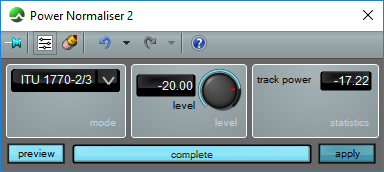Power Normaliser 2

It's often desirable to make disparate tracks and clips of audio sound equally loud to one another. When attempting to do so, you might expect that multiple tracks with the same peak amplitude would sound equally loud, but maximum peak level is a poor indicator of perceived loudness, and a piece of audio with a wide dynamic range will usually sound quieter than a piece of heavily compressed audio even though the peak levels of the two might be the same. Therefore, if you wish to set a track or segment to a desired perceived loudness, or normalise the perceived loudness of a group of tracks or segments, you should use Power Normalisation.
Power Normaliser 2 allows you to determine the power of a signal normalised to a user-defined value in the range -50dB to +20dB. Before normalising the power it is necessary to calculate the power of the existing audio, from which the process can determine the gain to be applied. There are numerous standards for this, and these can provide results that differ by many dBs from one another. CEDAR offers you a choice of seven standards.
RMS
This takes no account of the nature of the signal content, and determines the power using a calculation based upon each sample value. The value returned will often be higher than that calculated using the weighted functions below.
ITU 1770
Introduced in 2006, this was designed specifically for use in digital broadcasting. It has the advantage of greater accuracy than earlier methods when the programme content includes music as well as dialogue. It may be less suitable for normalising signals that comprise largely speech.
ITU 1770-2 and ITU 1770-3
These standards, which are identical for Power Normalising, use a 'gated loudness' approach that omits very quiet passages (such as the gaps between utterances) from the gain calculations., making them particularly suitable for signals that largely comprise speech.
A- B- C- and M- weighted measurements
Because the human ear is more sensitive to sounds in the range 1kHz - 4 kHz than those outside it, and because this response changes with overall loudness, audio that predominantly occupies these frequencies may seem louder than audio of the same loudness that lies predominantly above or below this range. Power calculations can be been carried out using weighting curves that compensate for the ear's response, and the most common of these are called A-, B- C- and M- weighted.
A-weighted:
This corresponds roughly to the equal-loudness curve for the human ear at moderate levels, so signals at the extremes of the audible range contribute less to the calculation than those in the mid-band. Wide-band signals will often return lower values using A-weighting than when the power is calculated using other methods.
B-weighted:
This lies between the A- and C- curves.
C-weighted:
This has a flat response over a much wider range that the A and B curves, and is suitable for measurements at very high signal levels, when the ear's response is closer to flat.
M-weighted:
Adopted by the film industry, this is used to assess the power when audio is heard at cinema playback levels.







